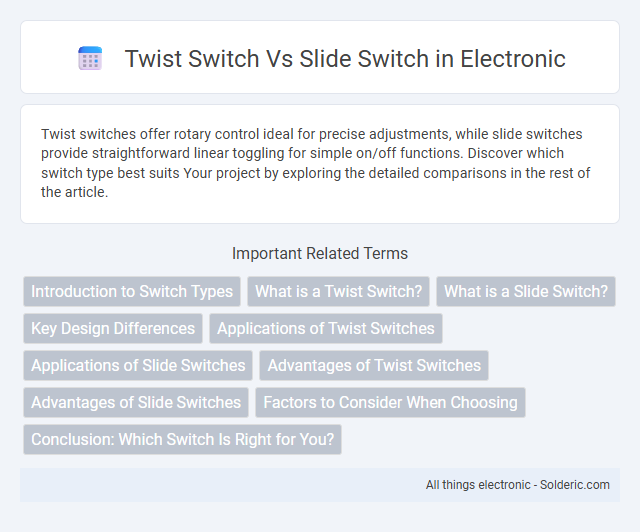Twist switches offer rotary control ideal for precise adjustments, while slide switches provide straightforward linear toggling for simple on/off functions. Discover which switch type best suits Your project by exploring the detailed comparisons in the rest of the article.
Comparison Table
| Feature | Twist Switch | Slide Switch |
|---|---|---|
| Operation | Rotational twist motion | Linear sliding motion |
| Typical Applications | Volume controls, dimmers | Electronic devices, circuit selection |
| Design | Cylindrical knob, multi-position | Rectangular or flat actuator, often on/off |
| Durability | Moderate, depends on quality | High, simple mechanism |
| Size | Bulkier due to rotary mechanism | Compact, low profile |
| Installation | Panel mount with threaded bushing | PCB or panel mount with solder terminals |
| Cost | Generally higher | Generally lower |
Introduction to Switch Types
Twist switches and slide switches serve distinct functions in electronic devices, with twist switches operating through rotational motion and slide switches using linear movement to open or close circuits. Your choice depends on the application, where twist switches offer precise control often found in dimmers or rotary selectors, while slide switches provide straightforward on/off or multi-position settings commonly used in small electronics. Understanding their mechanical design and operational differences helps optimize device functionality and user experience.
What is a Twist Switch?
A twist switch is a rotary device that controls electrical circuits by turning a knob or shaft to open or close contacts. It is commonly used in applications requiring variable settings or on/off control in a compact form, such as in lighting fixtures and household appliances. Your choice between a twist switch and a slide switch depends on the desired interaction style and space constraints.
What is a Slide Switch?
A slide switch is an electromechanical device designed to open or close an electrical circuit by sliding a knob or actuator along a linear path, commonly used for selecting between multiple circuit positions. It operates through a simple sliding motion that moves a contact point across terminals, providing reliable on/off or multi-position switching functionality. Slide switches are widely utilized in consumer electronics, toys, and control panels due to their compact size and ease of use.
Key Design Differences
Twist switches feature a rotary mechanism allowing users to activate or deactivate circuits by twisting the knob, whereas slide switches operate by sliding a lever back and forth to open or close electrical contacts. The compact design of twist switches is ideal for controlling lighting and small appliances in confined spaces, while slide switches offer precise control and tactile feedback often used in electronic devices and instrumentation. Material selection and contact configuration also differ, with slide switches typically providing more robust contact arrangements for multi-position settings compared to the simpler on/off orientation in twist switches.
Applications of Twist Switches
Twist switches are commonly used in applications requiring variable control, such as dimmer lights, fan speed regulators, and rotary volume controls in audio equipment. Their design allows for smooth adjustments in electrical devices where fine-tuning is essential. Your choice of a twist switch ensures precise modulation in household appliances and industrial machinery.
Applications of Slide Switches
Slide switches are widely used in consumer electronics such as remote controls, toys, and small appliances due to their simple on/off functionality and ease of operation. They are ideal for applications requiring compact design and reliable tactile feedback, making them suitable for handheld devices and circuit boards. Your projects benefit from slide switches' durability and straightforward installation in low-voltage, low-current environments.
Advantages of Twist Switches
Twist switches offer enhanced durability and resistance to accidental activation, making them ideal for industrial and heavy-duty applications. Their ergonomic design allows for precise control and tactile feedback, improving user experience and operational accuracy. Unlike slide switches, twist switches minimize dust and moisture ingress, increasing device longevity and reliability.
Advantages of Slide Switches
Slide switches offer precise control and reliable operation, making them ideal for applications requiring clear on/off positioning. Their compact design enables easy integration into small devices, while the simple sliding mechanism ensures durability and user-friendly interaction. You benefit from consistent performance and reduced mechanical wear when choosing slide switches over twist switches.
Factors to Consider When Choosing
When choosing between a twist switch and a slide switch, consider the switch's application environment, required durability, and ease of operation. Twist switches often provide tactile feedback and are suitable for devices needing precise control, while slide switches offer straightforward, quick state changes ideal for compact or portable electronics. Your choice should align with the device's mechanical constraints and user interaction preferences to ensure optimal performance and reliability.
Conclusion: Which Switch Is Right for You?
Choosing between a twist switch and a slide switch depends on the specific application and user preference. Twist switches offer precise control and durability, making them ideal for equipment requiring secure on/off settings, while slide switches provide ease of use and compact design suitable for consumer electronics. Assessing factors such as device size, user interaction, and environmental conditions will help determine the most appropriate switch type for your project.
Twist switch vs Slide switch Infographic

 solderic.com
solderic.com